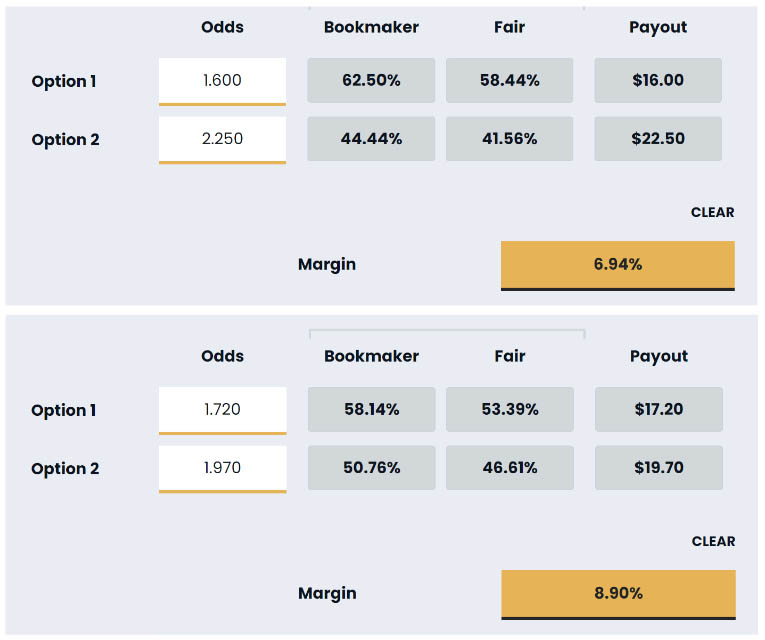The future of sports betting pt.2
The future of sports betting hinges on demographic changes, the rise of esports, and cryptocurrency adoption.

Creating an attractive offer for a bookmaker is the most important task to attract as many customers as possible. In addition to providing bonus offers to capture clients' attention and maintaining a very user-friendly interface, having a diverse selection of sports and markets is crucial for every bookie. However, the process of determining the prices displayed on the website and calculating the probability of each outcome is a key aspect that raises the question: How do bookmakers create these odds?
Bookmakers take into account various factors and variables that influence the pricing of odds. These factors are incorporated into complex algorithms, which then calculate and establish the pricing. The most significant factors affecting the odds include:
- Historical data
- Player/Team stats
- Form
- Home advantage
- Weather conditions
- Injuries and disciplines
These are some of the factors that determine the initial probability and the early odds set by the bookmakers. However, this is just the starting point for the bookmaker in adapting these prices and adjusting them to suit their target market and bettors. Probability plays the central role in setting the odds. After the probabilities are calculated they are converted into the odds which are deciding the potential payouts on either side of the market. The more probable the outcome to win the lower the odds will be, the less probable is for an event to occur the odds will be set higher.
Let's consider the easiest probability to calculate, which is 50%. Using the simplified formula 1/0.5=2.00, if you have two outcomes, each with a probability of winning the game, it will result in a price of 2.00 for each of the two outcomes.
So, these are the purest form of the odds, converted from the probabilities determined through the various factors mentioned above. However, those odds wouldn't generate any profit for the bookie, would they? If you offer two outcomes with a perfectly predicted 50% chance of winning for each and set the price at 2.00 for both outcome 1 and outcome 2, in an ideal scenario where all stakes are evenly spread on both outcomes, the bookie wouldn't make any profit.
Calculating the probability based on historical data is not the end of the work for the bookie. As explained above and in the article titled Betting Encyclopedia: Bookmakers Share," the bookie wouldn't make any profit in the long run if they used a 0% margin and offered fair odds to the customer.
In order to secure profits in the long run, the bookmaker has to establish some margins, which can vary from very low for the most attractive matches to relatively high for games in lower-tier leagues.
With more historical data available for a match, the probability calculation is considered more accurate. That's why the margins set for the biggest matches can vary from 1-5%, while for some lower leagues, they can exceed 10%.
The probability factors involve straightforward conversion of historical data into percentage probabilities and later into odds. However, the bookmaker's share is determined by the bookie through various factors, including:
- Tournament /Match importance
- Market sentiment
- Public perception
- Market movements
- Stake distribution
While many other factors are utilized, we will highlight just the most important ones. The software employed by bookmakers today continuously learns from experiences, becoming increasingly sophisticated with each market change.
As the tournament or match becomes more important, the probability is estimated more accurately due to the availability of a larger dataset. That is the reason why bigger matches will be cut off by smaller margins than the lower tier matches. Also one of the reasons is match fixing possibility so the bookie is trying to cut his potential risks.
Below is one example with two matches which are offered with 2% difference in margin for the totals market:


As a bookmaker, you need to be aware of the specific market you are covering and set the odds accordingly. For instance, if you are catering to the German market where a majority of bets are placed on Bayern Munich to win and many customers favor the Over outcome for total goals, these factors will likely push the odds for the mentioned outcomes slightly lower than the fair price. Conversely, the odds for the opposite side may be pushed higher than the fair price.
The market significantly influences pricing; any miscalculation in probability can result in higher-than-expected stakes on one side of the book. In such cases, corrections in pricing and adjustments to the odds will be necessary.
Just a decade ago, bookmakers or traders, as they were called, analyzed and inputted all these factors into the system, adjusting the odds in real-time, or even set the odds completely manually and conducted the entire monitoring manually, compared to other bookies. Today, bookmaker software has become more sophisticated, and numerous odds providers handle this aspect of work for the bookmaker. Major odds providers globally, such as Sportradar, offer comprehensive packages of products that are fully automated and execute all the aforementioned tasks for the bookie.

The future of sports betting hinges on demographic changes, the rise of esports, and cryptocurrency adoption.
Sports betting has evolved to online platforms with $45B revenue.Europe leads, Southeast Asia and Latin America show rapid growth, and crypto betting is rising.
Discover Fairspin's blockchain sportsbook: diverse offerings, user-friendly interface, competitive odds. Rated 9.1/10.
Discover Fairspin: Enjoy seamless payments with cryptocurrencies, enticing bonuses, and responsive support. Dive into our detailed review now!
Consider all pros and cons when betting on major events. Establish your limits, manage your bankroll, and maintain discipline.